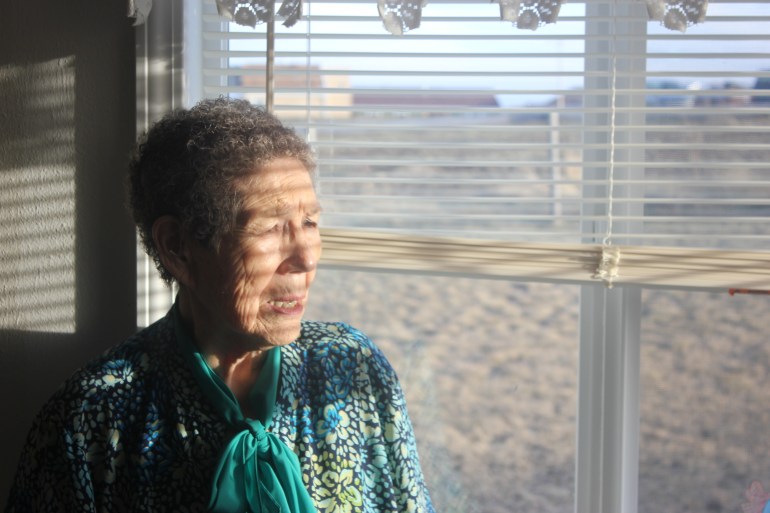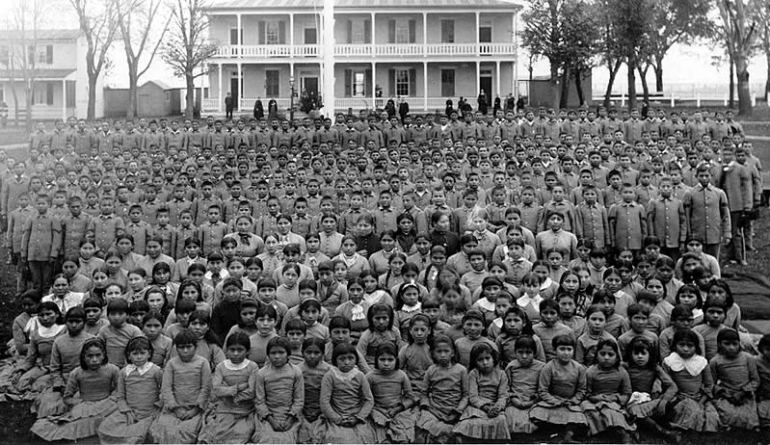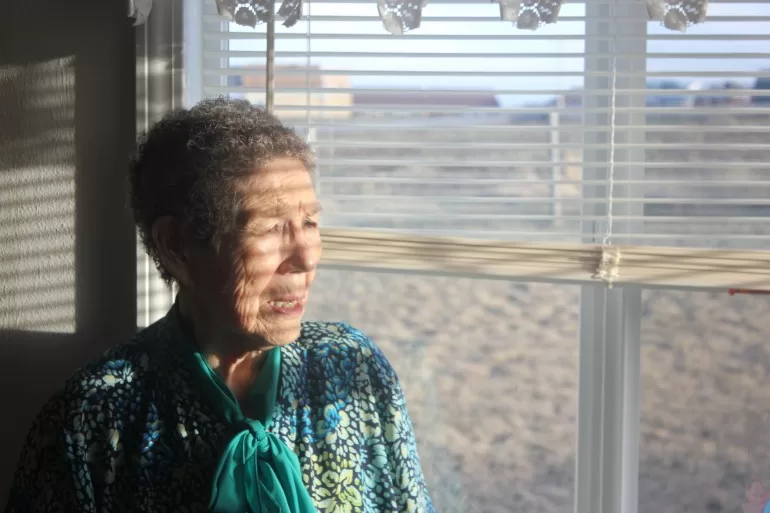Rosalyn LaPier still shudders when she thinks of the abandoned, windowless Victorian manor that sat next to a tiny chapel on the Montana reservation where she grew up.
Some weekends, as a child, LaPier would pass by the gloomy estate on her way to a local cemetery to pay respects to deceased relatives. Along the way, her grandparents would tell stories of the atrocities they endured and witnessed inside the foreboding property.
“Think Addams Family. Think death,” LaPier, an environmental historian and lecturer at the University of Illinois Urbana-Champaign, told Al Jazeera. “Fear is the way people thought of those places.”
The spooky building was a former Catholic boarding school for Indigenous children, part of a web of similar institutions across the United States where Native culture was actively suppressed — often with violence and abuse.
LaPier said that the decrepit wooden edifice had haunted generations in her family and community.
“They were all part of a system of genocide, which means to strip people of their identity, strip people of their names, their language, [down] to their religion, to their cultural practices,” LaPier, an enrolled member of the Blackfeet Tribe, explained.
That system of cultural erasure catapulted into the spotlight last month amid a tightly contested national election, when President Joe Biden formally apologised for the schools. He called them “one of the most horrific chapters in American history”.
“We should be ashamed,” Biden told an audience in the Gila River Indigenous Community in Arizona. “Native communities silenced. Their children’s laughter and play were gone.”
The apology came in the twilight of Biden’s presidency — and against the backdrop of the presidential election between his vice president, Kamala Harris, and former Republican President Donald Trump.
But some scholars and activists warn that Biden did not go far enough in his condemnation of the boarding school system. That, they say, could make a difference in mobilising the Indigenous vote.
One hundred and fifty years of pain
The residential school system has its roots in centuries of Western colonialism. But in 1819, the US government started to set aside funds to help introduce “the habits and arts of civilisation” to Indigenous peoples.
Religious groups used the money to set up schools, and in 1879, a US Army officer named Richard Henry Pratt set up the Carlisle Indian Industrial School in Pennsylvania, a prototype for many Indigenous boarding schools across the country.
Pratt had a catchphrase to sum up his goals: “Kill the Indian. Save the man.”
The Indigenous boarding school system endured in the US until the 1960s and ’70s. Tens of thousands of children were forcibly taken from their families and enrolled in the schools, which were largely run by churches.
Once there, their hair was cut, they were assigned English names, and they were forbidden to speak their native tongue, often under threat of physical punishment. Many of the children never came home. Some remain missing to this day.
Last year, a federal probe into the boarding schools, under the leadership of Interior Secretary Deb Haaland, found that the institutions became hotbeds of “rampant physical, sexual and emotional abuse; disease; malnourishment; [and] overcrowding”.
Burials continue to be discovered to this day at the school sites.
Intergenerational trauma
LaPier grew up in the shadow of one such school: the Jesuit-run Holy Family Mission. It opened in 1890 and operated for roughly 50 years, one of about 17 documented Indigenous boarding schools in the state of Montana.
The boarding schools were shuttered years before LaPier was born, but she told Al Jazeera the intergenerational impact weighs on her decades later. After all, she is the child and grandchild of boarding school survivors.
“The punishment was quite severe for a lot of children,” LaPier said.
She explained that her mother — Angeline Mad Plume-Aimsback — and her grandmother were frequently punished for speaking Blackfeet. Mad Plume-Aimsback even had her food withheld during mealtime as a penalty.
Her grandmother also witnessed a classmate die of lye poisoning, LaPier said, after repeatedly having her mouth washed out with soap for speaking her traditional language.
“Some children would have their mouths washed out with soap. Oftentimes, historically, it was lye soap. Lye soap is poisonous and you can die from that,” LaPier explained. “My grandmother witnessed another child die from lye poisoning. She also witnessed other children getting severely ill from lye poisoning.”
LaPier’s grandfather was also subjected to cruel and unusual forms of punishment.
“They would make them march for speaking their language, and they’d make a march endlessly, you know, kind of like military drills,” LaPier said.
“That’s a really common history that probably all children who went to boarding schools shared. And a lot of the stories that oftentimes get passed down to families are those stories about how children were punished for speaking their language.”
Indigenous children also received a feeble education at the institutions. Many schools prioritised religious teachings over meaningful educational instruction. Ultimately, the vast majority left with few vocational skills or educational knowledge — and a shattered cultural identity. Many fell into poverty.

A long-awaited acknowledgement
Sitting in a hotel room in Kansas City, LaPier said that she eagerly watched Biden’s apology, something she considered a milestone moment for Native communities across the US.
“Almost every Indigenous person that I know watched it,” she said. “It was a historic moment.”
LaPier added that Biden’s speech — which described the schools as a “sin” on America’s “soul” — prompted an outpouring of reactions.
“Everybody watched it. Everybody commented about it on social media. Everybody had something to say. Everybody called. People called relatives,” she said. “I called my mother. My children called their grandmother. There was a lot of communication between families after, before, during and after the apology. So, for Indigenous communities, it was a huge, huge event.”
Beth Margaret Wright, a lawyer for the nonprofit Native American Rights Fund, also tuned in to watch Biden’s apology. The president’s acknowledgement of this dark chapter in US history touched a nerve. Her own late grandparents met at an Indigenous boarding school in New Mexico, she said.
“I wish I could have shared this apology with them,” Wright told Al Jazeera over the phone from her home in Boulder, Colorado.
Today, part of Wright’s work involves the retrieval of Indigenous students’ remains from boarding schools on behalf of victims’ families.
“Boarding schools touch every single native person today,” she explained. “And we have so many stories that are tragic, but we also have so many stories from boarding schools that remind us how strong and vibrant our Native communities are.”

Missing the mark
Wright — and some Indigenous voters — still felt Biden’s apology missed the mark.
“One thing that I would have liked to see in the apology is the acknowledgement of what tribal nations have done themselves to address the impacts of the boarding school era,” she said. “And the strength and the generosity and the forgiveness that tribal nations have employed to address healing in their own communities from this era.”
LaPier, meanwhile, criticised Biden for not using stronger language when describing the harm the Indigenous boarding schools inflicted.
Other world leaders, including Pope Francis, have called the residential school system in North America genocide.
“I think that he [Biden] fell short,” LaPier said. “He said it was horrific. He said that trauma and terror happened, and that abuse occurred. So he did talk about the reality of what occurred there. But one of the things that he did not address is that this really was a policy of the United States government as part of an overarching framework of genocide towards Indigenous peoples. It has been part of this colonial process.”
Nonetheless, LaPier is one of the many Indigenous voters who are leaning towards Vice President Harris in the November 5 election. Indigenous communities have largely voted Democratic in recent decades.
And Harris’s campaign has fought to lock up Native votes across the country in the dying hours of the presidential race.
Following Biden’s visit to the Gila River Indian Community, vice presidential candidate Tim Walz stumped in Navajo Nation, the largest reservation in the country. It was the first time this election cycle that a member of a major-party presidential ticket had campaigned there.
Walz’s efforts ultimately paid off: Less than 24 hours before Americans head to the polls, Navajo Nation President Buu Nygren endorsed Harris for president.

With hours to go before polls open, it remains to be seen how — or if — Biden’s apology could mobilise the Native vote.
“I think it’s going to help get out the vote in Indian country,” said Oliver Semans, 68, the co-executive director of Four Directions Native Vote, a South Dakota voting rights organisation.
Semans, an enrolled member of the Rosebud Sioux Tribe, said Biden’s boarding school apology could help energise Indigenous voters to ultimately tip the scales in the favour of Democrats.
Indigenous peoples make up a significant portion of the population in key swing states like Arizona, Nevada, Wisconsin and Michigan, where Harris and Trump remain neck-and-neck in the polls.
Semans described the president’s apology as a “very important” issue to Indigenous voters around the US.
“I think you’re going to see a positive response. Ninety-five to 97 percent of the [Native] vote will go to a candidate of their choice that has done something that affects their life — and that would be President Biden and his apology.”
